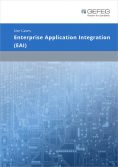The following sections describe scenarios in which GEFEG solutions can be applied and have already been successfully applied.
Do you develop interfaces together with other experts? Do you work with colleagues in different locations, but on the same data? Do you involve suppliers in data exchange with your company? Do you want to roll out new messages with a tight schedule? GEFEG software products support cooperation between user groups, also across companies and countries. Our users have various methods at their disposal, such as the use of repositories in the cloud with controlled access rights. All these methods are combined in a Dynamic Collaboration Framework.
In historically grown IT landscapes of large companies or after the merger of companies, hundreds of applications often communicate with each other via different interfaces. Mastering this diversity is a great challenge. In order to place, harmonise and consolidate the many interfaces on a uniform basis, a well-planned project is required in which many experts work together and which can certainly span several years. Supporting GEFEG solutions have already been used successfully in several projects.
In Germany alone, more than 32 billion invoices are exchanged annually, an estimated three-quarters of which are still exchanged using conventional methods, i.e. not electronically. GEFEG has at its disposal the most common national, European and international standards for electronic invoices as well as the know-how for their further specification. However, it is not only the standards for the presentation of the invoice content that must be observed. The legislator requires documentation of the eInvoice interface(s) used for tax reasons.
If you ask two people in your company from different departments what they mean by a “latest delivery date”, you will most likely receive different answers. In this case, it seems high time to clarify terms and establish a common understanding. This usually affects the different interfaces of your company or the metadata behind the interfaces. Before any electronic data exchange, whether at national or international level, terms must be clarified.
The number of interfaces that must be maintained in a company with “normal” EDI requirements over its entire life cycle is already very high in some cases. It is not uncommon for this number to be between 500 and 800. In extreme cases, we are talking about several thousand. As digitisation and networking (Industry 4.0) progresses, this number is likely to increase dramatically. GEFEG solutions, methods and experience help you to keep track of growing requirements.
GEFEG solutions allow messages to be tested for compliance with a standard or the specification of a standard. The results are error messages that you can define yourself if you wish. The checks can be performed on the desktop or easily made available to user groups on the Internet. For example, for the self-test in a rollout scenario.
Especially GEFEG’s portal solution offers support for the rollout of messages as well as onboarding of EDI partners. Usually we are not talking about a dozen, but about several hundred to thousands of partners involved in a company’s EDI solution. The time and personnel required for this is high. This involves questions such as processing, status, document provision and self-testing.
The term “Single Window” stands for the introduction of modern concepts and procedures in cross-border trade. The single window aims to provide the economic operators (transporters, processors, authorities, logistics companies,…) with exactly one application via which the entire information flows are processed. Read more in the following documents.
GEFEG solutions provide ready-made standards. However, they also enable the development of standards for industries, groups and companies. The multi-language capability, i.e. the ability to save names and descriptions in several languages, as well as the many possibilities for metadata import and export, provide support.






